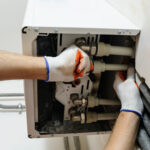 A water heater is an essential appliance in every household, providing us with hot water for bathing, cleaning, and other daily activities. However, like any other appliance, water heaters can experience problems over time. In this blog post, we will discuss some common water heater issues and provide tips on how to troubleshoot and resolve them.
A water heater is an essential appliance in every household, providing us with hot water for bathing, cleaning, and other daily activities. However, like any other appliance, water heaters can experience problems over time. In this blog post, we will discuss some common water heater issues and provide tips on how to troubleshoot and resolve them.
1. Lack of Hot Water:
One of the most common water heater issues is a lack of hot water. If you find that your water heater is not producing hot water or the hot water available is limited, there are a few potential causes. First, check the thermostat setting on your water heater. It may have been accidentally set to a lower temperature. Additionally, check if the pilot light is lit, as a blown-out pilot light can cause a lack of hot water. In some cases, sediment buildup in the tank can also affect the water heater’s ability to produce hot water.
2. Strange Noises:
If you hear strange noises coming from your water heater, such as banging, popping, or rumbling sounds, it may be an indication of sediment buildup in the tank. Sediment can accumulate over time and cause the heating elements to overheat or become less efficient. To resolve this issue, you can flush the tank periodically to remove the sediment. If the noises persist, it may be a sign of a failing heating element, and you may need to consult a professional for further assistance.
3. Water Leaks:
Water leaks are a serious issue that should be addressed immediately. A leaking water heater can cause damage to your home and result in costly repairs. If you notice water pooling around the base of your water heater or any visible signs of leakage, it is important to act swiftly. Check the pressure relief valve and the connections to ensure they are secure and not the source of the leak. If the leak persists, it may be due to a faulty valve or a crack in the tank, which will require professional attention.
4. Discolored or Smelly Water:
If you notice that your hot water is discolored or has a foul odor, it can be concerning. Discolored water can be an indication of rust or sediment in the tank, while a sulfur-like smell may be caused by bacteria in the tank. Flushing the tank can help remove sediment and alleviate discoloration. However, if the issue persists, it is advisable to contact a plumber who can assess the situation and recommend appropriate solutions.
5. Short Cycling:
Short cycling refers to a situation where the water heater turns on and off frequently, resulting in inconsistent hot water supply. This can be caused by various factors, including a malfunctioning thermostat, a faulty heating element, or an overheating issue. Check the thermostat setting and ensure it is at an appropriate temperature. If the problem persists, it is best to consult a professional technician who can diagnose and fix the underlying issue effectively.
6. Inadequate Water Pressure:
Low water pressure can be frustrating, particularly when it comes to taking showers or washing dishes. If you are experiencing inadequate water pressure, check if the pressure regulator valve is set correctly. Some water heaters also have a pressure relief valve that may need adjustment. Additionally, mineral buildup in the pipes can affect water flow, so consider descaling or flushing your water heater system to improve water pressure.
Conclusion:
Water heater issues can disrupt our daily routines and cause inconvenience. By understanding common problems such as a lack of hot water, strange noises, water leaks, discolored or smelly water, short cycling, and inadequate water pressure, we can better troubleshoot and resolve these issues. Remember to consult a professional plumber or technician for complex problems and ensure regular maintenance to prolong the lifespan of your water heater. By addressing water heater issues promptly and effectively, you can enjoy the comfort of hot water without any interruptions.

